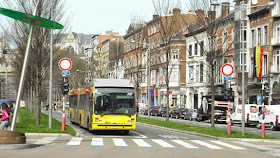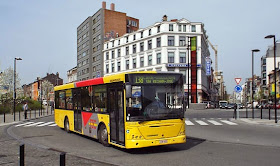In some areas, bus operators co-operate with each other to offer all-day tickets which are valid on all local buses. In some places, the all-day tickets may also include travel on ferries, trams, metro and/or local rail services. Where this is the case, the all-day ticket is often promoted and co-ordinated by a local authority or a local transport authority and generally valid only within that authority's area.
Imagine a ticket which is valid on both bus and railway services, and which ignores not only local authority boundaries but also national borders. Imagine such a ticket being offered across an area straddling three countries, where three different languages are spoken.
Such a ticket exists.
 The regional authorities in eastern Belgium, the north-western corner of Germany and the south of the Netherlands have formed the EU Regio Maas-Rhin.
The regional authorities in eastern Belgium, the north-western corner of Germany and the south of the Netherlands have formed the EU Regio Maas-Rhin.The euregioticket allows a day's unlimited travel by bus and rail across the region. At weekends, up to two adults and three children can travel together using one ticket. This also applies on public holidays.
Public holidays are different in each of the three countries but the ticket can be used as a group ticket on any day which is a public holiday in any of the three countries. So, for example, if it is a public holiday in Germany, a group could travel using one ticket on bus and train services in Belgium and/or the Netherlands.
In Germany, the euregioticket is valid in Aachen and around the surrounding region.




Aachen's bus services are coordinated by Aachener Verkehrsverbund (AVV), website in German only.
Services are operated with a variety of vehicles, including some bi-articulated buses.

A number of bus services operate from Aachen into the surrounding region. The euregioticket is valid for travel on these services, and on local rail services in the Aachen region.

 Most local train services into Aachen are provided by German operator DeutscheBahn.
Most local train services into Aachen are provided by German operator DeutscheBahn.There is a service into Aachen from Belgium, which is provided by Belgian rail operator SNCB/NMBS. The euregioticket can be used on this service too.
 While Belgian trains operate into Aachen, German trains operate a local cross-border service from Aachen into the Netherlands.
While Belgian trains operate into Aachen, German trains operate a local cross-border service from Aachen into the Netherlands.This image was taken at Heerlen.

The euregioticket is valid on the bus services which run into Aachen from the Netherlands and Belgium, as well as on local train services crossing the border.
 In the Netherlands, the euregioticket covers Maastricht and the surrounding area.
In the Netherlands, the euregioticket covers Maastricht and the surrounding area.Local buses in Maastricht, and within the surrounding part of the Netherlands, are provided by Veolia (website in Dutch only).

 Veolia also operate some of the local rail services into Maastricht, while other domestic services are provided by Nederlandse Spoorwegen (NS).
Veolia also operate some of the local rail services into Maastricht, while other domestic services are provided by Nederlandse Spoorwegen (NS).

Belgian trains also operate across the border into Maastricht on a service from Liège.
 De Lijn operate several bus routes into Maastricht from Hasselt, in the Flemish-speaking region of Belgium.
De Lijn operate several bus routes into Maastricht from Hasselt, in the Flemish-speaking region of Belgium.The euregioticket is valid into Hasselt and the surrounding region too.
 In Belgium's French-speaking Walloon region, bus services are generally provided under the TEC brand (website in French only).
In Belgium's French-speaking Walloon region, bus services are generally provided under the TEC brand (website in French only).The euregioticket is valid on buses in the city of Liège...



... and on bus routes serving the surrounding region.

 The main railway station in Liège has recently been rebuilt. The euregioticket can be used on the routes heading eastwards towards the German border, and northwards to Maastricht and Hasselt, as well as on the bus routes which serve the station.
The main railway station in Liège has recently been rebuilt. The euregioticket can be used on the routes heading eastwards towards the German border, and northwards to Maastricht and Hasselt, as well as on the bus routes which serve the station.These images show a train on the local service to Aachen in Spring 2014. This service was altered in December 2014, passengers using local trains between Liège and Aachen are now required to change at Verviers.

Long-distance high-speed Thalys and ICE trains provide a fast, direct link from Liège to Aachen, however the euregioticket cannot be used on those services.
 The images to the right and below were taken in the town of Spa. Spa can be reached by local trains and by bus. The euregioticket is valid on both.
The images to the right and below were taken in the town of Spa. Spa can be reached by local trains and by bus. The euregioticket is valid on both. The EU Regio Maas-Rhin is administered from the town of Eupen. Eupen lies in a small area of Belgium where German is the official language.
The EU Regio Maas-Rhin is administered from the town of Eupen. Eupen lies in a small area of Belgium where German is the official language.TEC provides the bus services in this area, however their website is only available in French.
From Eupen, buses operate into both Germany and the Netherlands.

The bus route linking Eupen with Aachen is shared between TEC and Aachen's transport undertaking, AVV.


TEC's route 396 links Eupen with Vaals, a Dutch town right on the border with Germany.
At Vaals it connects not only with services provided by Veolia but also with services operating as part of Aachen's local network.
Although some of Aachen's services terminate on the German side of the border at Vaals Grenze, others continue into Vaals itself.
This image was taken at Vaals Grenze, just within Germany, although the buildings in the background are in the Netherlands.

At weekends, a minibus service provided by Veolia operates from Vaals up into the hills where the Dutch, German and Belgian borders meet.
You may wonder why I have not mentioned any tram systems covered by the euregioticket. None of the cities it covers currently have trams. However, preparatory work started in 2014 to return trams to Liège (website in French only), while there are proposals for an interurban (and cross-border) tram system linking Hasselt with Maastricht (website in Dutch only).
The euregioticket is currently priced at €18. It can be bought from transport enquiry offices, ticket offices at staffed railway stations, ticket vending machines and on board buses.
Information about the euregioticket is available in English from the Belgian Rail website. A map showing the area of validity is contained within a leaflet in French, Flemish and German, which can be downloaded from the Aachen public transport (AVV) website.























































